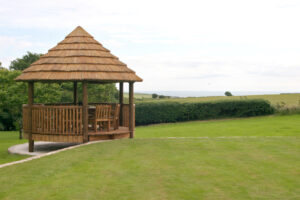A gazebo is a decorative, freestanding structure with a roof and open sides. They are most often found gracing gardens and outdoor spaces. Their design blends style with practicality, offering shade, shelter, and expansive views of the surrounding landscape.
Gazebos serve as an inviting retreat for various purposes, including relaxation, entertainment, and as a focal point for outdoor gatherings. Garden gazebos have an enduring appeal as they allow the great outdoors to be enjoyed regardless of the notoriously unpredictable British weather.
The design of gazebos may vary but there are distinctive elements – a raised platform or foundation for the best vantage point, open sides to embrace the beauty of nature and a roof, supported by pillars, columns or even trees, to crown the structure.
Traditionally crafted from materials such as wood, stone, or iron, gazebos have stood the test of time. Wooden gazebos remain popular to this day because of their natural, warm aesthetics, seamlessly harmonising with the garden setting.
Why is it called a Gazebo?
The origins of gazebos can be traced back to ancient civilisations, where similar structures had various uses. In ancient Egypt, gazebos were used for offering prayers, while in ancient Rome, they were often found in public gardens, providing shade and a place for social gatherings.
The term “gazebo” is believed to have originated in the late 18th century in England when these structures gained popularity. The word first appears in a book on modern designs for Chinese temples written by architects William and John Halfpenny.
The name is rumoured to be an 18th century joke word combining “gaze” with the Latin suffix ‘ebo’, meaning “I shall”.
While gazebos might not always have had this name, structures of their kind have been around in one form or other since time began. Gazebos were often built in elaborate garden settings as lookouts to enjoy the beauty of nature while providing a sheltered space for outdoor activities.
What is a Breeze House gazebo?
Breeze House introduced the first thatched garden gazebos to market in 1994. Founder, Andrew Peck was inspired by the timber and thatched roundavels he saw during a visit to Africa. Peck was captivated by the usefulness of these native, open-sided structures, for both shade from the sun and as perfect cover from heavy rainfall.
On his return, he set about crafting a version of these structures in his garage. The original Breeze House made its debut at the RHS Hampton Court Flower Show earning the admiration of visitors.
Today the Staffordshire Moorlands factory continues its legacy, meticulously crafting and installing luxury thatched and cedar-roofed garden gazebos. These gazebos offer a connection with nature without compromising comfort.
While many have attempted to emulate, Breeze House remains the original and unrivalled creator of luxury garden gazebos. Breeze Houses – as these creations have become known – are proudly owned by nature-lovers, families, footballers, celebrities, and influencers across the country.
Types of Gazebos
Shape
Gazebos come in various shapes, including square, rectangular, hexagonal, and octagonal. Each shape has its own aesthetic appeal and practical considerations. Circular and oval gazebos, however, are often considered some of the best designs due to their natural curves and adherence to the golden ratio.
The natural curves of these shapes create a sense of flow and balance in the outdoor space, enhancing the overall visual appeal. The use of curves in design is often associated with a more organic and inviting feel, in contrast to the sharp angles of some other shapes.
Circular and oval shapes are known to adhere to the golden ratio, a mathematical concept that is often found in nature and is believed to result in aesthetically pleasing proportions. In practical terms, circular and oval gazebos also provide a versatile and efficient use of space to provide comfortable lounging and dining areas whatever the footprint.
Circular
Nestled amongst lavish greenery with unobstructed views in all directions, a circular gazebo is a cosy retreat where you can escape the hustle and bustle of daily life. Experience the serenity of nature with Breeze House’s small to medium-sized luxurious circular gazebos.
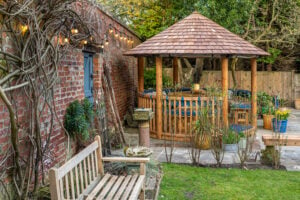
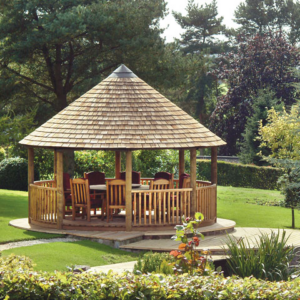
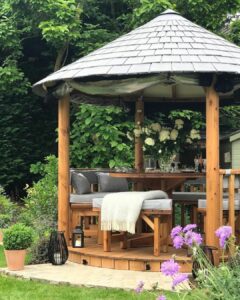
Oval
With the same immersive nature-based experience as a circular gazebo, an oval gazebo has more space to indulge and entertain. The Breeze House oval range offers twin areas for both lounging and dining.
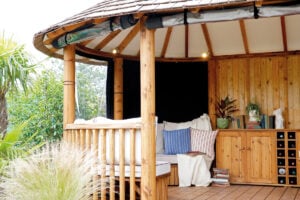
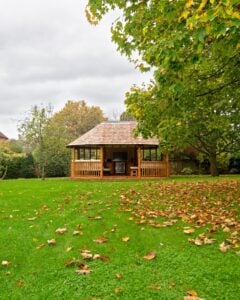
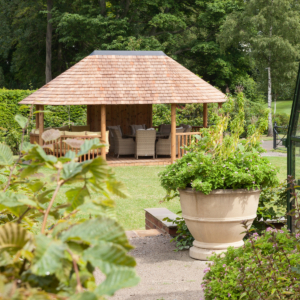
Bespoke
A bespoke gazebo offers endless possibilities. Exploring shape, height, and interior allows the flexibility to create anything from an indoor-outdoor space for a garden bar, swim spa or outdoor kitchen to a gazebo with multiple uses designed to your exacting specifications.
Breeze House’s bespoke design service gives you the opportunity to have a Breeze House custom built to a size and specification of your choice, meeting your practical needs and personal tastes.
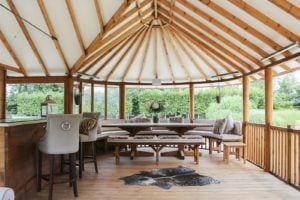
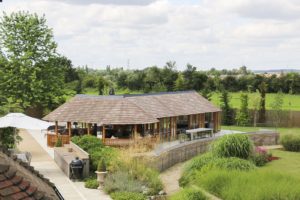
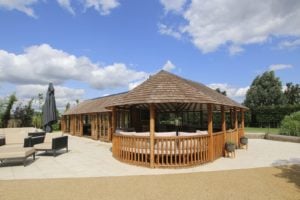
Material
Wood is widely regarded as the best material choice when it comes to constructing a gazebo, outshining alternatives like stone or iron.
Stone gazebos can be extremely costly and time-consuming to build, and their heavy and immovable nature makes them less versatile and challenging to relocate if needed.
Iron gazebos can be prone to rust and corrosion, which can significantly affect their durability and appearance over time. The cold and rigid nature of iron does not evoke the same warmth and inviting ambiance as a wooden gazebo.
Both stone and iron gazebos lack the customization options that wood offers, limiting the ability to create a personalised and unique structure. Overall, while stone and iron may have their merits, wood remains the superior choice for constructing a gazebo.
Wooden gazebos seamlessly blend into gardens, creating a harmonious and inviting atmosphere. Wood is a versatile material that can be shaped and crafted into specific designs, allowing for customisation, and it also provides a comfortable and cosy environment. Its natural properties, such as durability and insulation, make wooden gazebos a long-lasting and practical choice.
The exquisite collection of Breeze House garden gazebos are only crafted from the highest quality materials selected from sustainable sources.
Sustainable Scandinavian Redwood
Every Breeze House is handcrafted from resilient and sustainable Scandinavian Redwood, renowned for its durability and strength. The careful selection of timber is a crucial step in ensuring a Breeze House garden gazebo offers lasting beauty and structural integrity for years to come. Specifically chosen for their enduring qualities, these timbers not only maintain symmetry, style, and an impressive aesthetic but also age exceptionally well over time.
Read more about our materials here

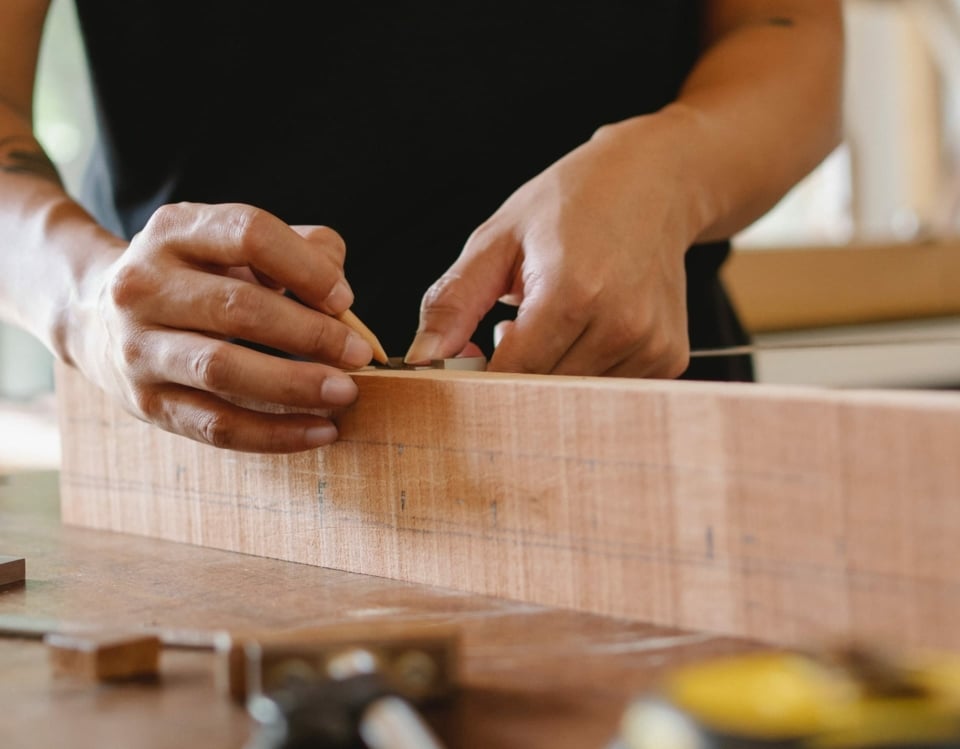
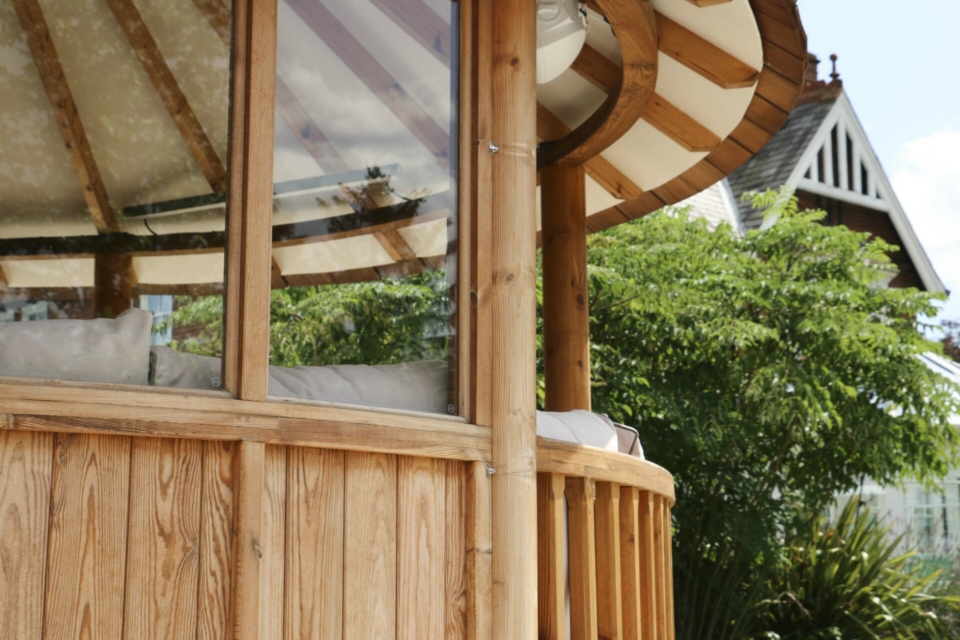
Roof
When it comes to choosing a roof for your gazebo, there are several options including: shingles, metal, thatch, polycarbonate panels and canvas. Factors such as budget, climate, aesthetics, and maintenance requirements are all important when choosing the best roof for your gazebo. Additionally, local building codes and regulations may impose restrictions on certain roof materials, so always verify these before making your final decision.
Breeze House garden gazebos come with a choice of roof options to suit the look and feel of your outdoor space and your personal preferences:
African inspired thatched roofing
Traditional African-inspired thatched roofing brings a touch of rustic charm and natural insulation to create a long-lasting yet unique-looking finish for your Breeze House. This type of roofing will naturally age and change colour over time.
Canadian Forest Cedar Shingle roof
Cedar roofs offer a classic and elegant look. This type of roof has a low rate of heat absorption for a cool touch even during summer months, and many natural traits including its own natural oil preservatives which make it resistant to rot and decay.
Slate effect tiles
Add a more contemporary look with the addition of slate effect tiles with the added benefit of being able to withstand exposure to harsher elements.
Read more about our materials here
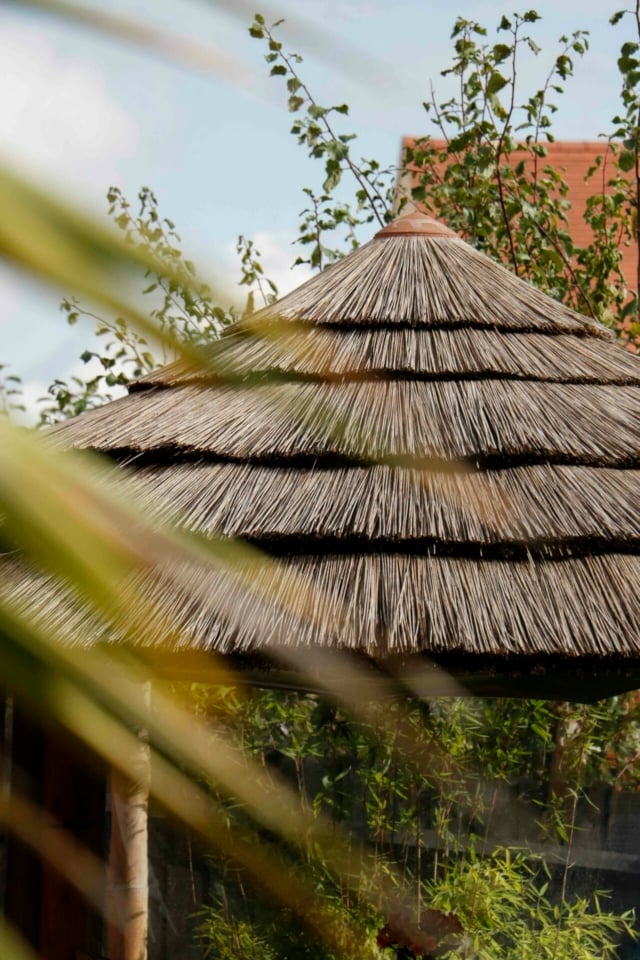
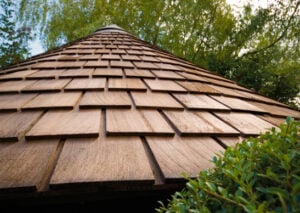
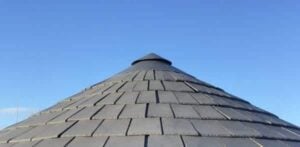
How to Use a Gazebo
A gazebo makes a garden a destination for several activities. Here are just some of the ways you can utilise this versatile garden retreat.
- Relaxation: Gazebos are an ideal space to relax and unwind. They offer a peaceful retreat in nature, providing shade and protection from the elements. Adding comfortable seating, pillows, and a small table can create a cosy spot to read, nap, or enjoy a cup of tea.
- Entertaining: Many gazebos are designed to accommodate outdoor entertainment. They can be used for hosting intimate gatherings, outdoor dining, or as an extension of your living space. Installing a grill, a small kitchenette, or a bar area can transform a gazebo into a perfect space for hosting parties.
- Gardening: Some gazebos are designed as a focal point for garden enthusiasts. They can be used as a sheltered area for potted plants or as a base for growing climbing vines. Adding hanging baskets, trellises, and decorative elements can enhance the garden aesthetic.
- Dining: Elevate your dining experience with the use of a gazebo; offering an ideal setting for a memorable al fresco meal. The open sides of gazebos provide a seamless connection to the surrounding environment, allowing you to indulge in your meal while immersing yourself in nature.
- Home gym: Transform a gazebo into a wellness sanctuary by setting up a home gym. Utilising the airy and open space of a gazebo can create an invigorating environment for workouts.
- Meditation: Create a serene meditation space with a gazebo. Nature sounds provide a soothing backdrop to elevate your practice.
- Outdoor kitchen: Enjoy cooking and dining in the fresh air, with the opportunity to prepare and indulge in food from plot to plate in the comfort of your garden. Summer entertaining suddenly becomes hassle-free and allows the chef to be a part of every conversation.
- Hot Tub Shelter: Gazebos are an ideal choice to provide shelter and privacy for a hot tub whilst still providing an open feel.
- Pool Cabana: Gazebos are a wonderful way to add some shade and shelter from the sun when you are relaxing by the pool or seeking a private place to change after a dip in the pool, but they also look elegant and stylish in your outdoor space.
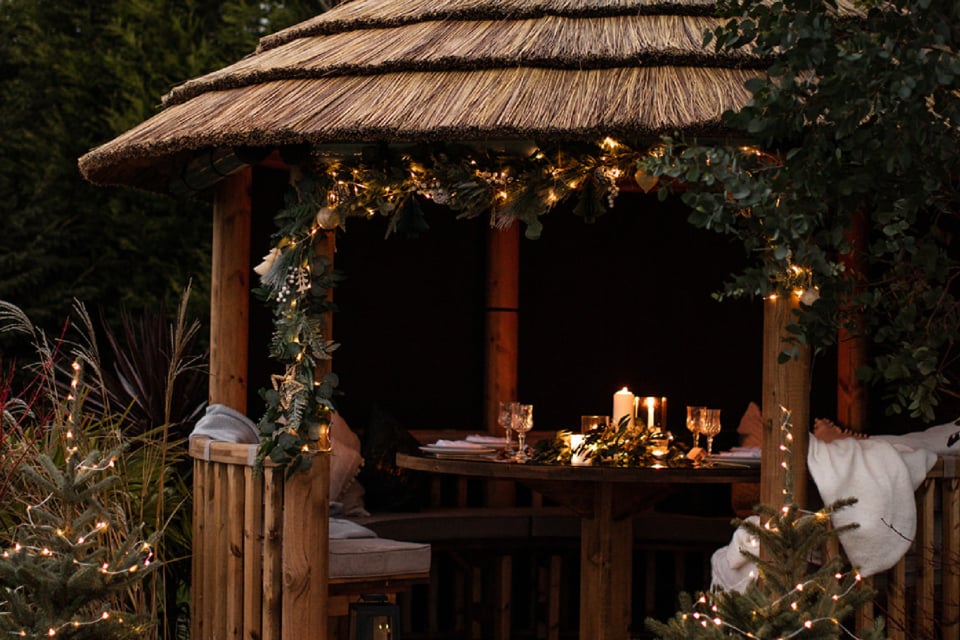

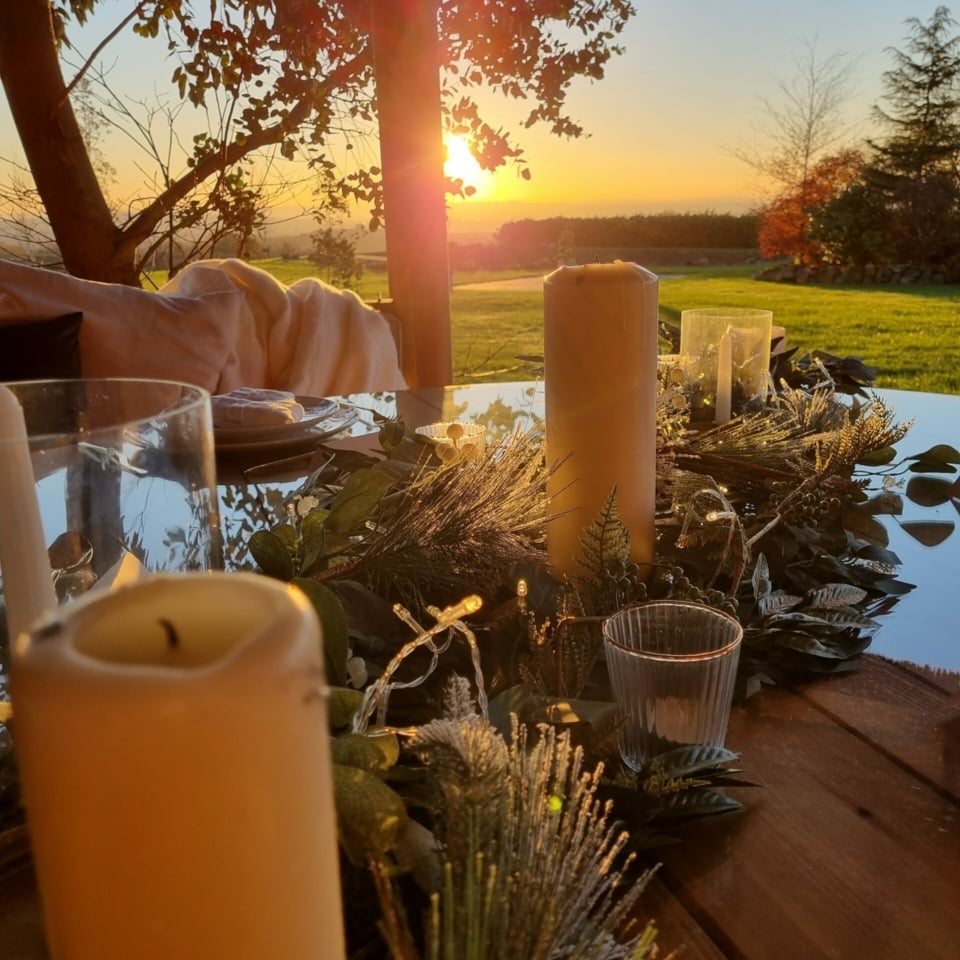
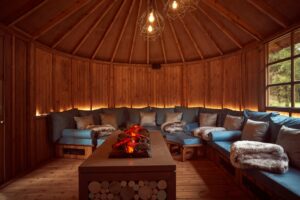
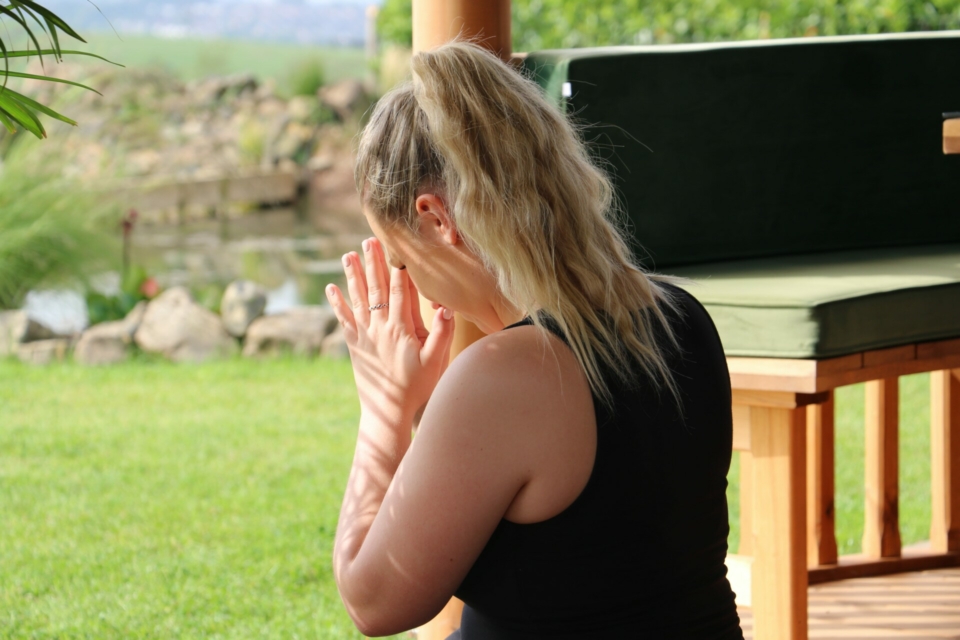
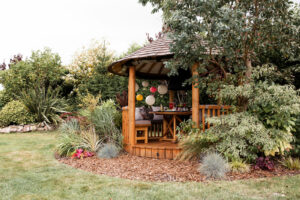
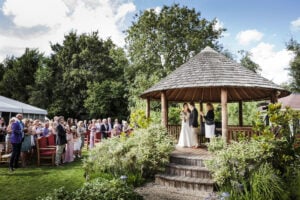


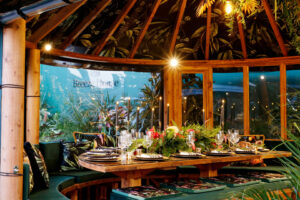
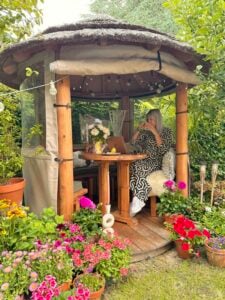
What Are the Features of Gazebos?
- Available in a range of sizes to suit any size of garden
- Customisation options to suit your style
- Furniture to adapt the space for dining or lounging or a combination of the two
- Accessories to weatherise your gazebo for use all year round
- Open sides to immerse yourself in nature
- The option to raise the building for an elevated view of your outdoor space
Did you know?
We offer a 30-year guarantee with every Breeze House garden gazebo purchased
What Are the Benefits of Gazebos?
- Shade from the sun
- Shelter from wind and rain
- Privacy
- Adds charm and a focal point to a garden landscape
- Versatility – use as a quiet retreat, for family gatherings, outdoor events, or intimate dinners
- Flexibility to make best use of your garden all year round
- Increase house value
- Relaxation and wellness – enjoy the stress-reducing benefits of being in nature without compromising comfort
Other Types of Garden Structures
A gazebo is a beautiful and functional outdoor structure that adds elegance and charm to any garden. Its design features, versatility, and various uses make it an appealing addition to any outdoor space. Whether you use it for relaxation, entertainment, or al fresco dining, a gazebo provides a cosy and inviting retreat to enjoy the outdoors.
Pavilions
Unlike a gazebo, a pavilion is a roofed structure with completely open sides and no built-in floor. The roof is typically supported by 4-6 posts or more, depending on the size, and they are usually attached to decking, a patio, or a concrete base. Most pavilions are designed to be long and rectangular and are commonly used to provide a roof for an already existing seating area below; whilst gazebos are a self-contained structure.
Pergolas
Pergolas tend to be much larger outdoor shade structures. They include a lattice-style roof that is supported by posts and are used to cover and define larger areas, including entire patios or outdoor seating areas. However, if privacy and protection are important factors for you then a gazebo is the more suitable option.
